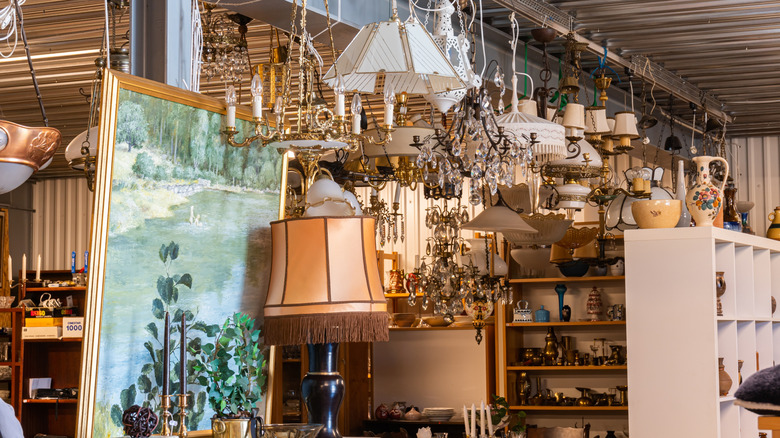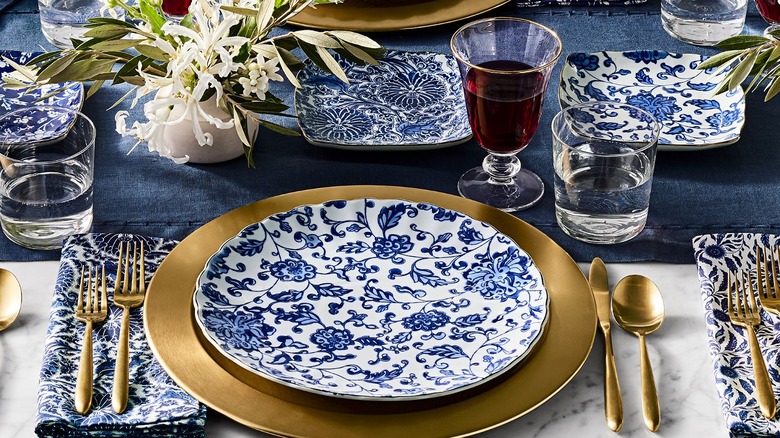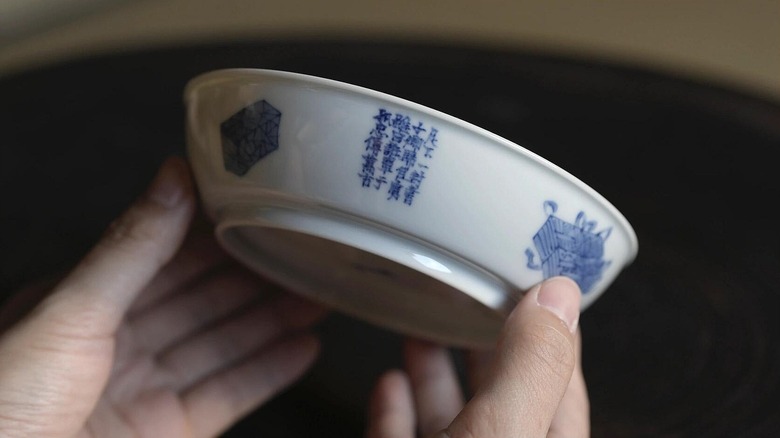The Once-Popular Vintage Decor Everyone's Snatching Up At Thrift Stores Again
You have definitely seen a version of them somewhere, whether it's in one of those big box home improvement stores, at your local antique shop, or maybe even on display in one of your grandmother's glass kitchen cabinets. You may not know the traditional name for them, or even their lengthy history, but you have most definitely come in contact with their famous shiny white glazed exterior and intricate blue designs. Traditional Chinese Qinghua porcelain, commonly referred to as blue and white porcelain, has been spotted everywhere lately, from Goodwill shelves, to TikTok, to the homes of popular interior designers.
As everything that was once considered old eventually becomes new again, home decor and art enthusiasts are scooping up all the Qinghua porcelain they can find at their local flea markets and antique shops, hoping to incorporate this timeless decor into their home and possibly find a piece of authentic and rare china in the process. Just like other Chinese traditions, including Feng Shui, this type of material has a long history that dates all the way back to the early 600s — and it is still being produced today. The porcelain is easily recognizable by its icy white glaze and notable animal, fruit, and floral designs painted on the surface in cobalt blue. The rare cobalt material was originally imported to China from Persia, and is still what makes this particular type of pottery so valuable.
There's so much to love about Qingua porcelain
There are many reasons why designers love Qinghua porcelain. As a respected art form across the world, it's been a popular collector's item in many countries for centuries. It's also been upheld by museums and auction houses as a highly sought after commodity because of both its artistic value and its status as a technological achievement. This type of ceramic is incredibly durable due to a firing technique that took years to perfect. The porcelain's strength comes from a combination of materials such as kaolin, feldspar, glass, steatite, quartz, and alabaster. The materials are fired at extremely high temperatures, creating a dense structure that's resistant to daily wear.
The firing process was invented in China 2,000 years ago where the making of the world's finest porcelain began and continues today. The historical significance of Qinghua porcelain only adds to the value of the popular decor item and has ensured blue and white porcelain remains a notable staple in the interior design world. It's used for everything from tableware sets to shelving accent pieces because it works well in both formal and casual settings, giving it an aesthetic versatility that not all porcelain can live up to. Another reason is that the vintage aesthetic works well in most spaces. Its neutral white and blue hues easily blend into most color pallets and elevate any space. It is an especially perfect choice for homeowners embracing a country living, modern farmhouse, or bohemian style design scheme.
How to spot and style the real thing
Rare and hard-to-find Chinese ceramics have sold for millions at auction, but that doesn't mean you have to take out a second mortgage in order to incorporate them into your home. Antiquers have been pilfering through vintage shops and garage sales armed with their favorite tips for thrifting home decor and looking for the real thing. If you're hoping to score authentic Qinghua at thrift store prices, make sure to look for "soft flaws" in the porcelain, like rust spots and tiny, spider web-like cracks known as crazing. These types of flaws indicate hundreds of years of aging and are helpful when trying to confirm the authenticity of antique porcelain. However, if you just want the look without the fuss, you can easily find modern equivalents online and at major home decor retailers for reasonable prices.
It's fun to note that one of the best things about Qinghua porcelain is that you can embrace a wide range of patterns and shades of blue. It's easy to mix and match styles, and the subtle variation can create a more personalized look, especially if you're using these pieces in your dining room. You can pick up a range of blue and white porcelain plates, cups, and bowls, in all types of styles, as long as you aim for a cohesive look. You can do this in a variety of ways. The easiest is by focusing on a key shade of blue that will tie multiple pieces together, but you can also add dimension by including Qinghua vases or multi-tiered platters for height.


